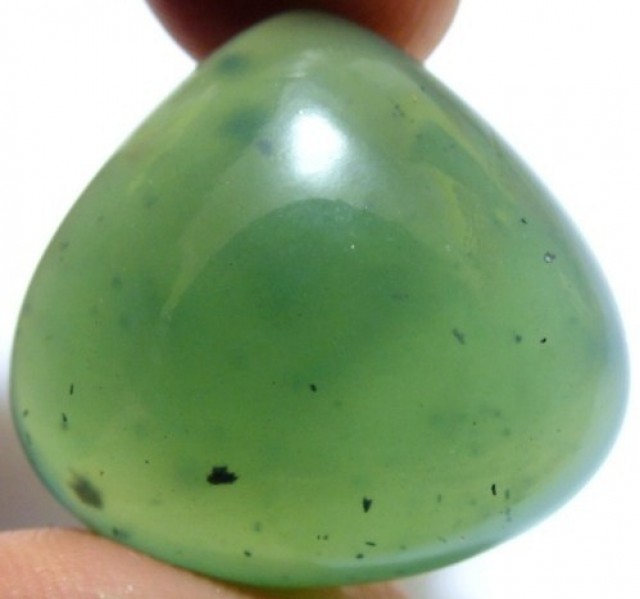
翡翠が本物か偽物かを見分ける方法
J 
テストと観察
不規則性があるということは、おそらく本物である
明るい光にかざしてください。可能であれば、10倍のルーペで内部構造を観察してください。繊維状または粒状の、フェルト状、アスベストのような絡み合ったものが見えますか?もし見えたら、それはおそらく本物のネフライトまたはジェダイトです。模造品としてよく使われるクリソプレーズは微結晶なので、均質に見えます。10倍のルーペで層のようなものが見えたら、おそらく「二重」または「三重」に重ねられたジェダイト(宝石質のジェダイトの薄い層を別の台座の上に接着したもの)でしょう。

翡翠の密度を確認する
比重比重試験は、下記の方法で行うことができます。また、石を空中に投げて手のひらでキャッチすることで、より正確ではないものの密度を判定することもできます。同じ大きさのほとんどの石よりも重く感じる場合は、本物の翡翠である可能性が高いです。
密度を判断するもう一つの方法は、プラスチックビーズが優しくぶつかり合う音を観察することです。本物の翡翠をお持ちの場合は、問題の石に当ててカチャカチャと音を立ててみてください。プラスチックビーズのような音がする場合は、おそらく偽物です。
ジェダイトとネフライトはどちらも非常に高い密度を持っています(ジェダイトは3.3、ネフライトは2.95)。密度は、重量(グラム)を体積(cc)で割ることで測定されます。
コールドテスト
翡翠を手に取ってみてください。触ると「冷たく、滑らかで、石鹸のような」感触があるはずです。本物であれば、温かくなるまでに少し時間がかかるはずです。ただし、これは非常に主観的な判断なので、形や大きさが似ている本物の翡翠と比較すると、より分かりやすくなります。
スクラッチテストを実行する
翡翠は非常に硬いため、ガラスや金属にさえ傷がつきます。しかし、ネフライトは非常に柔らかいため、傷のテストを不適切に行うと、本物の翡翠を傷つけてしまう可能性があります。はさみの鈍い方を使って、翡翠の目に見えない部分(底や端など)を優しく押して線を引いてください。風化した表面は翡翠よりもはるかに柔らかく、傷つきやすいため、避けてください。傷が白い線になった場合は、優しく拭き取ってください(はさみの金属片の可能性があります)。それでも傷が残っている場合は、おそらく本物の翡翠ではありません。
ガラスや鋼鉄に傷がつく場合は、緑色の水晶やプレナイトなど、翡翠の代替品が数多くある可能性もあります。
このテストは自己責任で行ってください。翡翠で作られていなくても、非常に貴重な品物である可能性があり、傷がつくと価値が大きく損なわれる可能性があります。
その他の欺瞞行為を探す
たとえ本物の翡翠を手に入れたとしても、染色、漂白、安定化ポリマーの使用、ダブレットやトリプレットの作成といった加工を施すことができます。翡翠はこれらの可能性に基づいて3つのカテゴリーに分類されます。
タイプ A - 天然、未処理、伝統的なプロセス(梅ジュース洗浄および蜜蝋による研磨)を経ており、「人工処理」(高温または高圧処理など)は行われておらず、「本来の」色です。
タイプ B - 化学的に漂白して不純物を取り除き、遠心分離機を使用してポリマーを注入して半透明性を高め、硬くて透明なプラスチックのようなコーティングで覆われています。ポリマーは熱や家庭用洗剤によって分解されるため、時間の経過とともに不安定になり、変色する可能性がありますが、それでも 100% 本物の翡翠であり、100% 自然な色です。
タイプ C - 化学的に漂白され、色を強調するために染色されており、強い光、体温、家庭用洗剤との反応により時間の経過とともに変色する可能性があります。
模造翡翠について知ろう
ジェダイトとネフライト翡翠は本物の翡翠です。ニュージーランドでは、グリーンストーン、またはポウナムはマオリの人々から高く評価されています。マオリの人々は、色と透明度によってカワカワ、カフランギ、アナンガの4種類のポウナムを認識しています。これらはすべてネフライトです。また、ミルフォードサウンド産のタンギワイという4種類目のポウナムも高く評価されています。これはボーウェン石であり、世界の他の地域では真の翡翠とは見なされていません。
翡翠として販売されている他の素材には以下のものがあります。
アベンチュリンクォーツ

マレーシア翡翠(色によって赤翡翠、黄翡翠、青翡翠と呼ばれることもある、永久染色された半透明の石英)
不透明ドロマイト大理石(「山の翡翠」 - アジア産、鮮やかな色に染められています)
密度試験の実践ガイド
必要な機材 -
バネ秤(テストする部品の重量に応じて、100グラム、500グラム、または2500グラム)
翡翠を浸すのに十分な大きさのバケツ
文字列
ポニーテールホルダー
輪ゴム
ペーパータオル(物を乾かすため)
説明書 -
ワニ口クリップを使って翡翠を掴んでください。秤にワニ口クリップが付属していない場合は、紐、輪ゴム、またはポニーテールホルダーで翡翠を包んでください。
バネ秤の上部のハンドルを持ち上げて、空中での翡翠の重さを記録します。(この秤はグラム単位なので、力の測定単位はダイン(CGS)です。)
翡翠を水を入れたバケツに完全に静かに入れ、水中での重さを記録します。クランプは水に触れても構いませんが、重量に大きな影響を与えることはありません。ご心配な場合は、上記の代替手段のいずれかをご使用ください。このテストは重量の差に基づいているため、紐、バンド、またはポニーテールホルダーが空中でも水中でも翡翠に付いている限り、重量差は同じになります。
翡翠の体積を計算します。空気中の重量を1000(電卓をお持ちの場合は981)で割り、水中の重量を1000(電卓をお持ちの場合は981)で割ります。これで空気中の質量(グラム)と水中での見かけの質量が求められます。空気中の質量から水中の質量を引くと、cc単位の体積が得られます。
翡翠の密度を計算します。空気中の質量を体積で割ってください。翡翠の密度は3.20~3.33 g/cc、ネフライトの密度は2.98~3.33 g/ccです。
翡翠を買う
Gemstone Encyclopedia検索
最新記事
ヤシ象牙彫刻は、植物象牙とも呼ばれ、南米のヤシ科植物フィテレファス属のヤシの実から倫理的に採取された、象牙の天然代替品です。このガイドでヤシ象牙についてすべて学びましょう!
15th Jan 2026
レインボーラティスサンストーンは、様々な内包物によって3つのゴージャスな光学的効果を持つ長石の一種です。燃えるように鮮やかな色合いと格子模様が、コレクターにとって希少な宝石となっています。
12th Jan 2026
記事のカテゴリ
How To's is where you will find helpful articles from gem Rock Auctions on how to cut gemstones, select gemstones and buy gemstones.
9記事数





